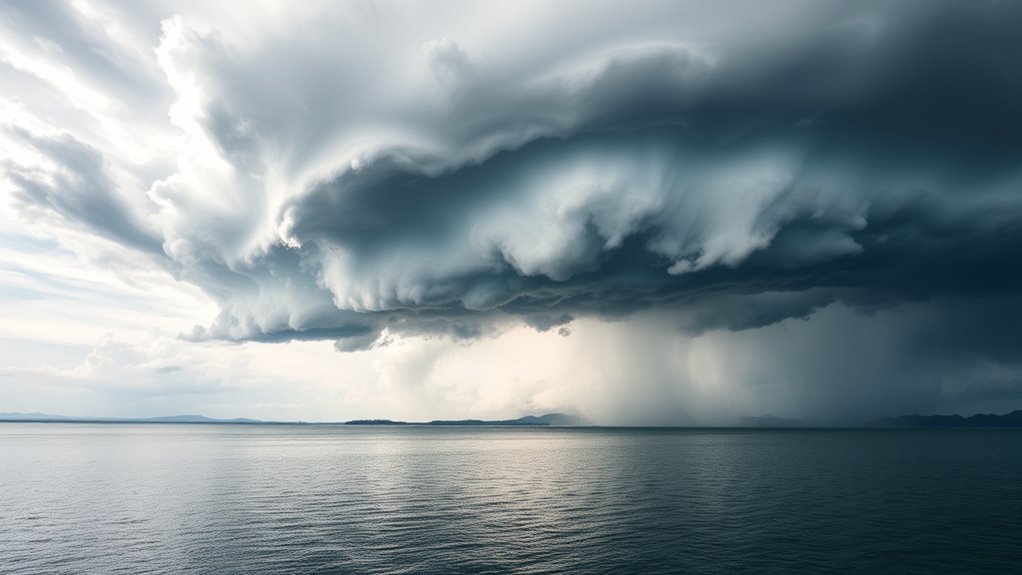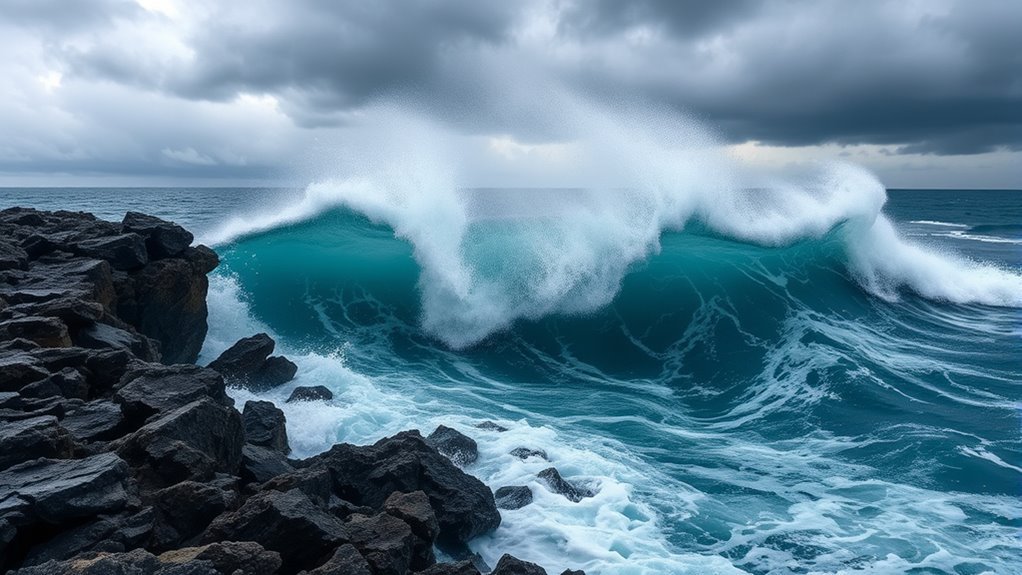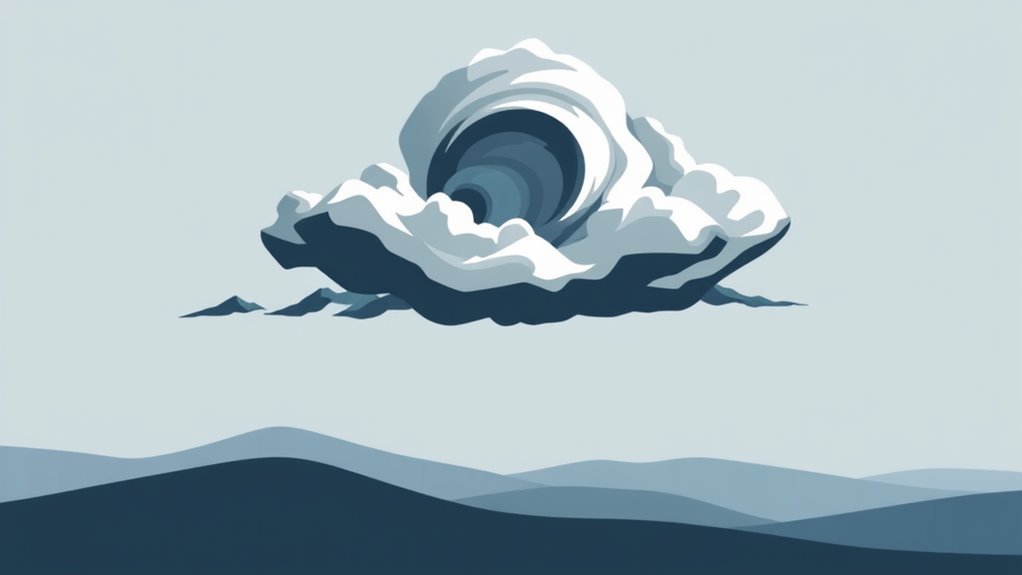Climate change is increasing the intensity of squalls due to rising global temperatures. Higher temperatures improve evaporation from bodies of water, leading to increased atmospheric moisture. This moisture acts as fuel for storms, making squalls more severe and frequent. Additionally, changes in wind patterns contribute to the development of stronger squalls. Understanding these dynamics is essential for anticipating the impacts of climate change on weather patterns and community preparedness. More knowledge on this topic await further exploration.
Main Points
- Rising global temperatures increase evaporation rates, contributing to more moisture in the atmosphere which fuels squall formation.
- Enhanced atmospheric moisture leads to higher storm intensity and frequency as it provides additional energy for storm systems.
- Warmer ocean temperatures alter wind patterns, resulting in more intense squalls and changes in their geographical distribution.
- Increased humidity enhances latent heat release during condensation, intensifying wind speeds and storm development.
- Climate change causes regional variations in squall activity, with coastal areas experiencing more severe squalls due to rising sea temperatures.
Understanding Squalls: Definition and Characteristics
Squalls are sudden, sharp increases in wind speed, often accompanied by brief bursts of heavy rain or thunderstorms. These meteorological phenomena can occur in various environments, frequently associated with cold fronts or convective activity.
Characteristically, squalls can manifest as localized wind events that develop rapidly, sometimes catching observers off guard. The intensity of the wind can escalate dramatically within a short time frame, leading to hazardous conditions, especially for maritime and aviation activities.
Typically, squalls can last from a few minutes to half an hour, but their impacts can be significant. They may include not only strong gusts but also changes in temperature and humidity.
The precipitation associated with squalls can vary, ranging from light rain to torrential downpours. Understanding these characteristics is essential for preparing and responding effectively to their sudden onset, minimizing risks to life and property in affected areas.
The Role of Rising Global Temperatures

Rising global temperatures markedly influence weather dynamics, leading to increased evaporation rates.
This heightened evaporation contributes to altered weather patterns, which can intensify squalls.
Understanding these changes is essential for predicting and mitigating the impacts of climate change on storm behavior.
Increased Evaporation Rates
How are increased evaporation rates influencing climate patterns?
Rising global temperatures lead to higher evaporation rates from oceans, lakes, and rivers. This process contributes to an increase in atmospheric moisture, which can intensify weather phenomena. The additional moisture available in the atmosphere serves as fuel for storm systems, potentially increasing their intensity and frequency.
Warmer temperatures also boost the rate of evaporation, particularly in tropical regions, which can alter local climates and ecosystems. As water vapor accumulates, it can create conditions that favor the development of squalls, defined by sudden, intense bursts of wind and precipitation.
Understanding the relationship between evaporation and climate dynamics is essential for predicting the future behavior of squalls and related weather events.
Altered Weather Patterns
What happens to weather patterns as global temperatures continue to rise? As the planet warms, atmospheric circulation changes, leading to altered weather patterns.
Warmer temperatures increase the capacity of the atmosphere to hold moisture, which can intensify precipitation events. Consequently, regions may experience more extreme weather, including stronger squalls and unpredictable shifts in storm paths.
Additionally, rising temperatures can disrupt established seasonal patterns, resulting in prolonged droughts in some areas while others may see increased flooding.
The interplay between rising temperatures and atmospheric dynamics contributes to a greater frequency of severe weather events. This shift not only impacts local ecosystems but also poses considerable challenges for agriculture, water resources, and disaster preparedness efforts globally.
Changes in Atmospheric Conditions
As climate change progresses, substantial alterations in atmospheric conditions become evident.
Rising sea temperatures contribute to increased humidity levels and influence altered wind patterns.
These shifts play an essential role in the formation and intensity of squalls, impacting weather systems globally.
Rising Sea Temperatures
Rising sea temperatures are progressively altering atmospheric conditions, greatly impacting weather patterns and climate dynamics. As the oceans absorb more heat, they influence the formation and intensity of squalls.
Warmer waters improve evaporation, supplying additional moisture to the atmosphere, which can fuel more powerful storms. In addition, rising temperatures can alter wind patterns, affecting how squalls develop and move.
- Increased ocean heat leads to more vigorous weather systems.
- Warmer seas can result in stronger squall formations.
- Altered wind currents change storm trajectories.
- Improved evaporation contributes to storm intensity.
These interconnected factors illustrate the critical role of rising sea temperatures in shaping the future of squalls and their potential consequences on affected regions.
Increased Humidity Levels
While various factors contribute to changes in atmospheric conditions, increased humidity levels play an important role in the development and intensity of squalls. As global temperatures rise due to climate change, the atmosphere can hold more moisture.
This heightened humidity provides additional fuel for storm systems, leading to more vigorous squalls that can produce heavy rain, strong winds, and lightning. The presence of moisture improves convective activity, which is vital for squall formation.
Consequently, regions experiencing higher humidity may witness more frequent and severe squalls, impacting ecosystems, infrastructure, and communities. Understanding the relationship between humidity and squall intensity is essential for predicting weather patterns and preparing for potential hazards associated with these increasingly volatile storms.
Altered Wind Patterns
Altered wind patterns greatly influence the development and behavior of squalls, as climate change reshapes global atmospheric dynamics. As temperatures rise, changes in wind direction and speed can lead to more intense and frequent squalls.
These alterations are primarily driven by shifts in high and low-pressure systems, which affect how air masses interact with each other. Consequently, the following aspects are vital in understanding this phenomenon:
- Increased wind shear may contribute to the formation of more severe squalls.
- Warmer ocean temperatures can improve the energy available for storm development.
- Changes in the jet stream can lead to erratic weather patterns.
- Localized wind patterns can intensify squall-related precipitation and gusts.
These factors collectively signify the need for further study on squall dynamics in a changing climate.
The Connection Between Humidity and Storm Intensity

Humidity plays a crucial role in determining storm intensity, as it directly influences the amount of energy available for storm development. When the air is saturated with moisture, it can contribute to the formation of powerful storms. High humidity levels can lead to increased latent heat release during condensation, which further fuels storm dynamics.
As warm, moist air rises, it creates low-pressure areas that can intensify wind speeds and generate severe weather conditions. Conversely, lower humidity can suppress storm formation, limiting the energy available for growth.
In a warming climate, increased surface temperatures can boost humidity levels, creating a more favorable environment for squalls and other storm systems. This connection between humidity and storm intensity highlights the importance of monitoring atmospheric moisture as a key factor in predicting the severity of storms, particularly as climate change continues to alter global weather patterns.
Regional Variations in Squall Patterns

As climate change continues to reshape weather patterns globally, regional variations in squall activity have become increasingly pronounced. Different areas are experiencing unique shifts in the frequency, intensity, and duration of squalls.
For instance, coastal regions often face more severe squalls due to rising sea temperatures, while inland areas may deal with sporadic but intense squall events influenced by changing atmospheric conditions.
These variations can be attributed to several factors:
- Geographical features: Mountains and valleys can alter wind patterns, affecting squall formation.
- Ocean currents: Changes in ocean temperatures and currents influence humidity and storm development.
- Urbanization: Growth of cities can create microclimates, impacting local squall activity.
- Seasonal shifts: Altered seasonal weather patterns can lead to unexpected squall occurrences.
Understanding these regional differences is essential for improving forecasting and preparedness strategies.
Impacts on Communities and Infrastructure
While squall activity varies regionally, the impacts on communities and infrastructure are universally substantial. Increased squall intensity can lead to severe property damage, disrupting essential services such as electricity, water supply, and transportation.
Infrastructure, including roads and bridges, is particularly vulnerable to the force of high winds and heavy rainfall, resulting in costly repairs and prolonged disruptions.
Communities often face economic setbacks due to business interruptions and loss of agricultural productivity. Emergency services are strained, as they must respond to increased incidents of flooding, fallen trees, and structural damage.
Public health concerns also arise, with potential contamination of water sources and increased risks of accidents during severe weather events. In the end, the compounded effects of intensified squalls challenge the resilience of communities and necessitate thorough assessments of vulnerabilities to safeguard lives and resources.
Strategies for Preparation and Adaptation
How can communities effectively prepare for and adjust to the increasing frequency and intensity of squalls? A diverse approach is essential for resilience against these extreme weather events.
Communities must prioritize the improvement of infrastructure, ensuring that buildings and roads can withstand severe winds and flooding. Additionally, local governments should implement early warning systems to alert residents about impending squalls.
Furthermore, public awareness campaigns can promote community preparedness by educating residents on emergency protocols. Investment in green spaces can also mitigate flooding, as vegetation helps absorb excess rainwater.
- Develop and reinforce infrastructure to withstand extreme weather.
- Implement advanced early warning systems for timely alerts.
- Conduct public awareness campaigns on emergency preparedness.
- Improve green spaces to enhance flood management.
Common Questions
How Do Squalls Differ From Other Storm Types?
Squalls are brief, intense storms defined by sudden winds and heavy precipitation, differing from other storm types by their rapid onset and short duration. Typically, they occur in maritime environments, highlighting their unique atmospheric conditions.
What Are the Warning Signs of an Approaching Squall?
The warning signs of an approaching squall include sudden drops in temperature, darkening skies, increased wind speed, and the appearance of towering clouds. Observers may also notice a rapid change in humidity and atmospheric pressure.
Can Squalls Form in Dry Climates?
Squalls can indeed form in dry climates, although less frequently than in humid areas. Factors such as sudden temperature changes, wind shifts, and localized atmospheric disturbances can trigger the development of these intense weather phenomena.
Are Squalls Predictable Using Current Technology?
Squalls can be somewhat predictable using current technology, such as radar and satellite imagery. Nevertheless, their sudden onset and rapid changes in intensity still pose challenges for meteorologists, leading to potential inaccuracies in forecasts.
What Historical Events Illustrate Squall Intensity Changes?
Historical events such as the 1938 New England hurricane and the 1978 blizzard demonstrate considerable increases in squall intensity. These instances illustrate how evolving weather patterns have led to more severe and unpredictable squall occurrences over time.

